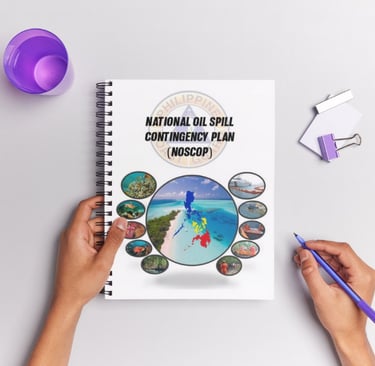Philippines NOSCOP: Strengthening National Oil Spill Response and Preparedness
The Philippines National Oil Spill Contingency Plan (NOSCOP) is the country’s official framework for responding to oil spill incidents. As an archipelago with over 36,000 kilometers of coastline and some of the world’s busiest shipping lanes, the Philippines faces significant risks from marine oil pollution. At GS Oceanguard Inc., we support NOSCOP’s mission by providing world-class oil spill response equipment and services to safeguard our marine environment.
8/16/20252 min read


What is the Philippines NOSCOP?
The NOSCOP is a strategic plan developed under the leadership of the Philippine Coast Guard – Marine Environmental Protection Command (PCG-MEPCOM) in cooperation with other government agencies, port operators, and private stakeholders.
Its main goal is to ensure rapid, coordinated, and effective action during oil spill emergencies—whether caused by ship accidents, offshore drilling incidents, or onshore oil facility leaks.
Key Objectives of NOSCOP
The NOSCOP outlines clear objectives to protect lives, property, and the marine ecosystem:
Prevention and Preparedness – Promote safe vessel operations, port safety standards, and preventive maintenance of oil facilities.
Rapid Response – Ensure oil spill containment and recovery within the shortest possible time.
Coordination Among Agencies – Establish a unified command system between the Coast Guard, local government units, and industry stakeholders.
Environmental Protection – Minimize long-term damage to coral reefs, mangroves, seagrass beds, and fisheries.
Community Involvement – Train local communities and coastal barangays in basic oil spill awareness and response techniques.
The Three-Tier Response System
NOSCOP follows an internationally recognized Tiered Response System:
Tier 1: Small spills handled by facility or ship operators using their own equipment.
Tier 2: Larger spills requiring assistance from other ports, companies, or regional responders.
Tier 3: Major spills exceeding national capacity, requiring international assistance.
This system ensures that responses are proportionate, efficient, and cost-effective.
Why NOSCOP Matters to the Philippines
The country’s heavy reliance on maritime trade and its location along major oil shipping routes mean that oil spills are an ongoing risk. Without a coordinated plan like NOSCOP, response times could be delayed, leading to devastating impacts on:
Fisheries and Livelihoods – Oil contamination can close fishing grounds for months.
Tourism – Polluted beaches and dive sites can harm the tourism industry.
Marine Biodiversity – Coral reefs, mangroves, and marine species suffer long-term damage.
GS Oceanguard Inc.’s Role in Supporting NOSCOP
As a trusted supplier of oil spill response equipment in the Philippines, GS Oceanguard Inc. provides solutions that directly enhance NOSCOP implementation, including:
Containment Booms – To encircle and contain oil slicks at sea or nearshore.
Oil Skimmers – For efficient recovery of oil from water surfaces.
Dispersants – Approved formulations for breaking down oil slicks safely.
Oil Spill Kits – For ports, vessels, and coastal facilities.
Training and Drills – In partnership with port authorities, shipping lines, and LGUs to improve response readiness.
By supplying ready-to-deploy oil spill equipment and supporting simulation exercises, GS Oceanguard helps ensure that NOSCOP objectives are met effectively.
Building a Safer, Cleaner Future
The Philippines NOSCOP is more than a government document—it’s a national commitment to protect our seas, coastal communities, and future generations.
Through continuous improvement, equipment modernization, and stakeholder cooperation, the Philippines can remain ready to respond to any oil spill incident, big or small.
At GS Oceanguard Inc., we are proud to be part of this mission. Together, we can strengthen oil spill resilience and protect our nation’s marine treasures.
Here is the link to view and download the Philippines National Oil Spill Continengcy Plan
Location
3195 New Panaderos, Santa Ana, Manila, Metro Manila
Contacts
+63927 410 4369
info@gsoceanguard.ph

